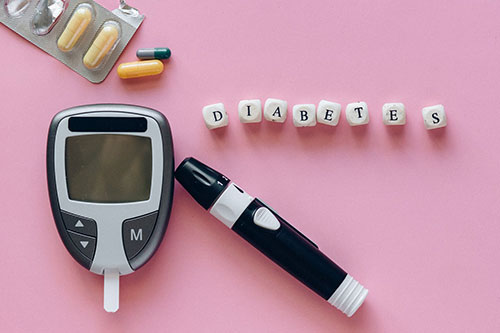Diabetes and Peripheral Vascular Disease (PVD)
“You are as old as your arteries.” – An old saying
India has the second largest diabetic population (about 60-70 million) in the world and is considered the diabetes capital of the world. 6-8% of these patients are expected to be suffering from peripheral vascular disease (PVD) which is a huge number. South India which accounts for a majority of the diabetic population in India has a higher incidence of PVD compared to cardiovascular disease.
PVD is a condition characterized by atherosclerotic disease of the lower extremities. This atherosclerosis refers to the deposition of fat like substance in the arterial wall – like soot in a chimney.

When the artery narrows due to atherosclerosis, it can slow down or stop blood flow to those parts supplied by that artery. That organ suffers due to lack of oxygen and nutrients supplied by the blood. When this narrowing occurs in the artery supplying the heart it causes heart attack. When it affects the brain, it causes stroke, and in the leg, it causes gangrene of the toes or foot (death of tissue).
Diabetes and smoking are the most common causes of developing blocks in the arteries. These can be hastened by several other concomitant risk factors, some of which are modifiable and others not.
Non-Modifiable Risk Factors
- Age
- Duration of diabetes
- Nerve damage due to diabetes
- Family history of PVD
- Family history of heart disease
Modifiable Risk Factors: –
- Overweight
- Lack of exercise
- Smoking
- High blood pressure
- High LDL cholesterol
The most common symptom of PVD is intermittent claudication, defined as pain, cramping, or aching in the calves, thighs, or buttocks that appears reproducibly with walking, exercise and is relieved by rest. When the arterial block becomes more severe, walking becomes difficult and pain appears after walking a few steps or even at rest. Further deterioration leads to painful ulcers or gangrene (blackening of the limb). Diabetic patients can develop diminished sensation in the foot due to nerve damage. In these patients, typical pain may be absent and instead they will have the following:
- Feeling of numbness or cold in the lower legs
- Infections or ulcers on the feet or legs
- Hair loss on the legs or feet
- Non-healing of ulcers
- Nail changes
Diabetes not only raises the risk of getting PVD, it can worsen PVD quickly in a short time. Patients who smoke and are diabetic have a very high risk of developing arterial blocks. The longer the duration of diabetes, greater is the chance of getting PVD. Moreover, it can affect both men and women equally.
The initial assessment of PVD in patients with diabetes should begin with a thorough medical history and physical examination to help identify those PVD risk factors, symptoms of claudication, rest pain, and/or functional impairment. Two important components of the physical examination are visual inspection of the foot and palpation of peripheral pulses. Palpation of peripheral pulses by an experienced doctor helps in early detection of peripheral vascular disease and its management.
The type and location of arterial block can be assessed by a Doppler scan which is a non-invasive test. When the block is severe, another non-invasive test, a CT arteriogram is done which provides a road map of the artery.
Management includes medical as well as surgical options. Medical options are considered in mild disease and surgical options reserved for severe critical limb ischaemia. Delay in identifying or reporting to a doctor lead to more extensive blocks and an invasive surgical correction of the arterial blocks.
Medical Treatment:
Stop smoking and all other forms of tobacco
Regular exercise and walking
Proper foot wear and foot care
Blood thinners like aspirin
Cholesterol lowering drugs like statins
Control of diabetes, hypertension
Lifestyle modification
Majority of the patients can be managed medically if detected early.
Intervention:
Those who present late with severe pain and tissue damage require intervention to improve the blood flow immediately to prevent amputation. Intervention can be open surgery which may be removal of block (endarterectomy) or bypass operation. Open operation is used when the block is long and not suitable for endovascular intervention. In bypass operation, the patient’s vein is used as a conduit. If the vein is not available, an artificial graft can also be used.
Nowadays, endovascular intervention is used to clear most of the blocks as the first choice. In this, a small tube is inserted into the artery at the groin or elbow and a wire is passed into the artery across the block. A balloon is passed over the wire and the artery is dilated. Sometimes, a stent is deployed to keep the artery open. The advantage of endovascular intervention is that it is done under local anaesthesia and the patient can resume activities immediately. But there is a higher chance of recurrence of block as compared to bypass surgery. Bypass surgery has a greater success rate and long-standing relief but carries the disadvantages of complications of anaesthesia and open surgery and longer recovery time.
However, all patients should continue the medical treatment after intervention and come for regular check-ups.
What a Diabetic Should Do
- Keep blood sugar levels under control. Your goal should be HbA1c under 7%.
- Quit smoking and all forms of tobacco consumption.
- Lower your blood pressure and cholesterol.
- Diet – Consult a dietician for appropriate diet.
- Blood thinners like aspirin help to keep blood flowing well.
- Regular Exercise – Physical activity at least 4-5 days a week for a minimum of 30 minutes.
- Proper Foot Care and Footwear – Consult your doctor for appropriate footwear.
- Regular Foot Self-Examination – Should be done daily to identify problems earlier.
- Regular consultation to assess the circulation in the foot.
What a Diabetic Should Not Do
- Walking Bare Foot – Leads to blisters due to poor sensation in the foot.
- Exposure of the foot to extremes of temperature (dipping the leg in hot water or ice fomentation).
- Bath room surgery (cutting the corns).
- Walk with new foot wear for longer than 2 hours at a stretch.
- Smoking or tobacco use.
Approximately 27% of patients with PVD demonstrate progression of symptoms over a 5-year period leading to major amputation as well as heart attacks. Hence, it is very important for people with diabetic condition to protect their feet to lead a normal life.

Dr. N. Sekar
Chief Vascular and Endovascular Surgeon,
Kauvery Hospital, Chennai

